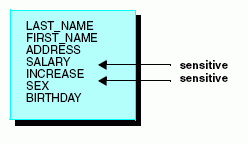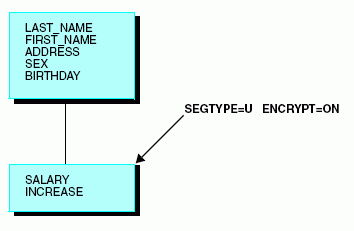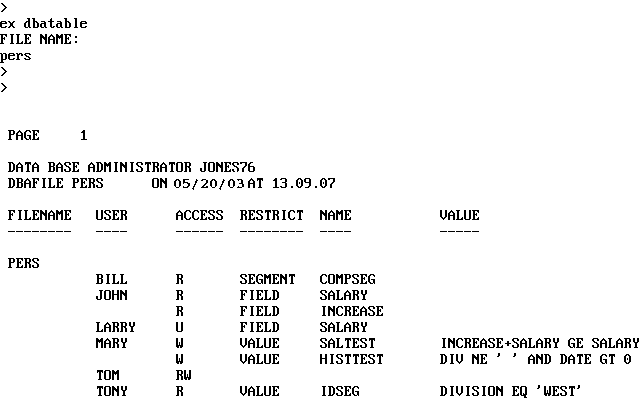Hiding Restriction Rules: The ENCRYPT Command
Since the restriction information for a FOCUS data source
is stored in its Master File, encrypt the Master File in order to
prevent users from examining the restriction rules. Only the Database
Administrator can encrypt a description. You must set PASS=DBAname before
you issue the ENCRYPT command. The syntax of the ENCRYPT command
varies from operating system to operating system. See
the Overview and Operating Environments manual for
information on your operating system.
x
Syntax: How to Hide Restriction Rules: ENCRYPT Command
ENCRYPT FILE filename
where:
- filename
Is the name of the file to be encrypted.
Example: Encrypting and Decrypting a Master File
The following is an example of the complete
procedure:
SET PASS=JONES76
ENCRYPT FILE PERS
The process can be reversed in order
to change the restrictions. The command to restore the description
to a readable form is DECRYPT.
The
DBA password must be issued with the SET command before the file
can be decrypted. For example:
SET PASS=JONES76
DECRYPT FILE PERS
x
You may also use the ENCRYPT parameter within the Master
File to encrypt some or all of its segments. When encrypted files
are stored on the external media (disk or tape) each is secure from
unauthorized examination.
Encryption takes place on the segment level. That is, the entire
segment is encrypted. The request for encryption is made in the
Master File by setting the attribute ENCRYPT to ON.
Example: Encrypting Data
SEGMENT=COMPSEG, PARENT=IDSEG, SEGTYPE=S1, ENCRYPT=ON,$
You
must specify the ENCRYPT parameter before entering any data in the
data source. The message NEW FILE... must appear when the encryption
is first requested. Encryption cannot be requested later by a change
to the Master File and cannot be removed after it has been requested
or any data has been entered in the data source.
xPerformance Considerations for Encrypted Data
There is a small loss in processing
efficiency when data is encrypted. Minimize this loss by grouping
the sensitive data fields together on a segment and making them
a separate segment of SEGTYPE=U, unique segment, beneath the original
segment. For example, suppose the data items on a segment are:

They should be grouped as:

Note: If you change the DBA password, you must issue the
RESTRICT command, as described in How to Change a DBA Password.
xDisplaying the Decision Table
When entering security attributes for a Master File,
FOCUS creates an internal decision table that lists users and the
access privileges. You can display the decision table associated
with a given data source whenever the Master File of the data source
is not encrypted. Since you have to decrypt your Master File when
you change or augment passwords, you can request a decision table
picture to check your work. You can also decrypt your Master File
to check your decision table. In FOCUS, after you have decrypted
your file, type EX DBATABLE and provide the file name when prompted
for it.
x
Syntax: How to Display the Decision Table
EX DBATABLE filename, {LONG|SHORT}where:
- filename
Is the name of the Master File for which you want a decision table.
- LONG
Displays 66 characters in the NAME column.
- SHORT
Displays 18 characters in the NAME column.
Note: The
DBATABLE procedure is supplied with FOCUS. Contact your system administrator
if you cannot locate it.
Example: Displaying the Decision Table
The following example displays the decision
table for the pers data source.

xSetting a Password Externally
Passwords can also be set automatically by an external
security system such as RACF®, CA-ACF2®, or CA-Top Secret®. Passwords
issued this way are set when FOCUS
first enters and may be permanent (that is, not alterable by subsequent
SET USER, SET PASS, or -PASS commands). Or they may be default passwords that
can be subsequently overridden. The passwords may be permanent for
some users, defaults for other users, and not set at all for other users.
The advantage of setting FOCUS
passwords externally is that the password need not be known by the
user, does not require prompting, and does not have to be embedded
in a PROFILE FOCEXEC or an encrypted FOCEXEC.
Passwords set this way must match the passwords specified in
the Master Files of the data sources being accessed.
See your installation documentation for FOCUSID
installation instructions.


